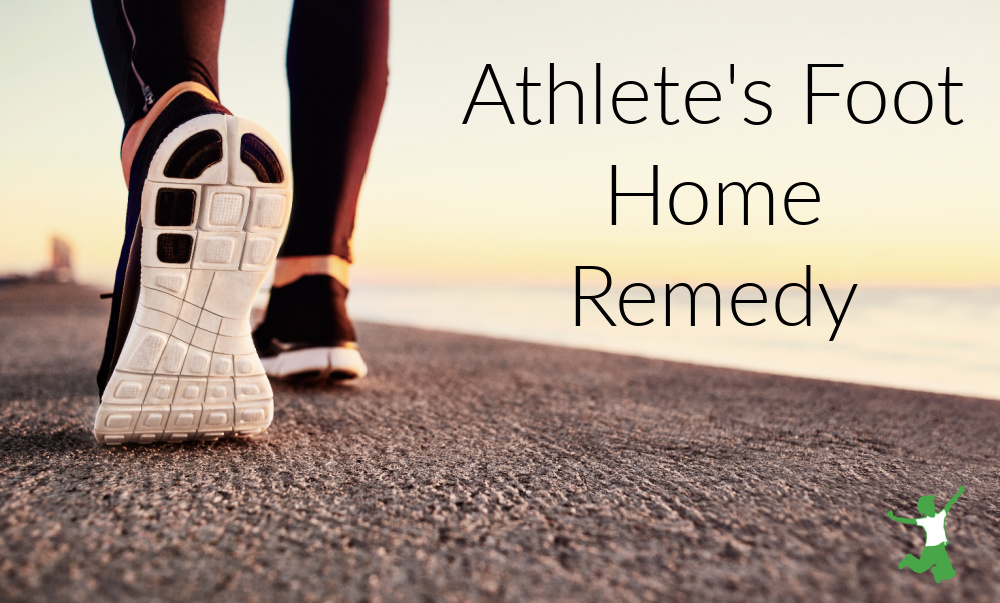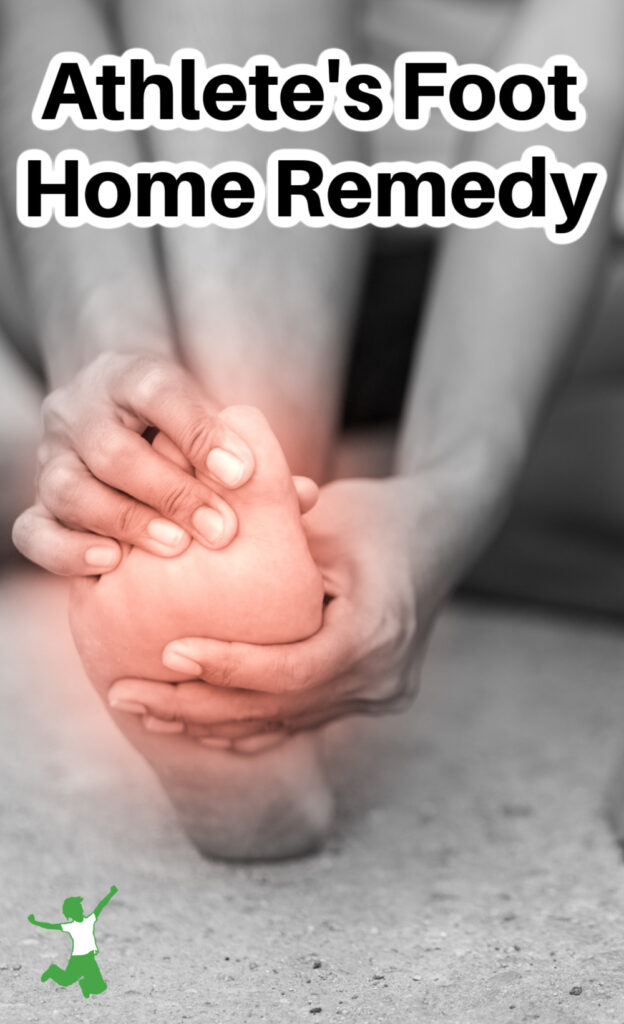A safe, effective antifungal foot soak using either boric acid or borax to eliminate infections such as Athlete’s foot instead of over-the-counter creams with toxic ingredients and possible side effects.

When feet are itchy, scaling, or peeling, a fungal infection of the skin is commonly the cause. Cracked heels can be a sign of fungal overgrowth of the skin too.
Scientifically speaking, the fungi that cause Athlete’s foot or tinea pedis are dermatophytes. These critters invade and grow in dead keratin, which is the outermost layer of skin. Keratin is also found in hair and nails.
For dermatophytes to cause an overgrowth in the keratin, warmth, and moisture are usually needed too. This is why the feet are a usual target for problems with Athlete’s foot.
Why Avoid Over-the-Counter Antifungal Creams
One of the most common antifungal creams for feet is Lotrimin, available over-the-counter at most pharmacies.
The ingredients of this cream include:
Benzyl Alcohol, Cetyl Alcohol, Cetyl Esters Wax, Octyldodecanol, Polysorbate 60, Sorbitan Monostearate, Stearyl Alcohol, Water
The directions say that this cream should be used daily for 4 weeks to eliminate the fungus causing the infection. This would likely require several tubes of the product over a 1-month period at a cost of roughly $50 total.
While the ingredients in this cream are not a serious hazard, they are not benign either. Some of the ingredients might be absorbed into the bloodstream via the skin. (1-3)
In this case, side effects could include: (4)
- dry mouth
- sore tongue
- tooth pain
- red or swollen gums
- altered sense of taste
- nausea
- diarrhea
- headache
Such a long list for an external use-only cream that is supposedly safe and sold over-the-counter!
Boron Heals Foot Fungus Naturally
Why risk these side effects and pay $50 over a period of 4 weeks when it is much less expensive, faster, and safer to make a foot soak yourself with natural substances that contain boron, one of the most potent natural antifungals?
This type of home remedy was recommended decades ago by physicians who used to make house calls!
My Dad was this type of doctor, and his go-to remedy for all things fungal-related for the feet was boric acid.
Boric acid is a concentrated form of boron. It is marketed as roach or insect powder at the hardware store, but don’t let this put you off!
It is also highly antifungal and can be used by humans externally too!
A bottle of boric acid is going to set you back about $6 and will easily make enough foot detox soaks until the Athlete’s foot is completely gone….usually about a week.
Not only is a boric acid just as effective as Lotrimin, but it is also much less expensive with no side effects. It even works faster!
How to Make an Antifungal Foot Soak
Making an old-fashioned foot soak with boric acid as recommended by MDs years ago is quite simple.
Once you have a lightweight foot basin at the ready (such as this one), follow these simple instructions. Do not use it if there are any open cuts, sores, or wounds on the feet.
- Wash feet in the shower or bath with mild soap and water, rinse, and pat dry.
- Add three quarts of warm filtered water to a small foot basin.
- Mix in 1.5 tablespoons of boric acid until completely dissolved.
- Soak feet for 15-20 minutes.
- Wash feet in mild soap and water again, rinse feet, and pat dry with a clean towel.
- Leave feet exposed to the open air for at least an hour before putting on socks or shoes.
- Repeat once a day for a week or until symptoms resolve.
Can You Use Borax for Athlete’s Foot?
Borax is a less concentrated form of boron than boric acid. This substance can be useful for eliminating fungal-related foot infections as well.
If you wish to use borax instead of boric acid, make a foot soak using the instructions below instead. Again, do not use this method if there are open sores, cuts, or wounds on the feet. (5)
- Pour a quart bottle of 3% hydrogen peroxide into a small foot basin. The H2O2 helps the borax penetrate foot and nail crevices better. You may omit it if you prefer.
- Add two quarts of hot (not boiling) filtered water to the bucket. Add three quarts if omitting the H2O2.
- Mix 1 cup plain borax into the foot basin until completely dissolved.
- Place feet into the basin. The solution should completely cover the feet.
- Soak for 15-20 minutes, then remove feet from the basin, and pat dry with a towel. Do not rinse.
- Repeat once a day for a week or as long as necessary until the Athlete’s food is gone.
No Soaking Method
Another method that is much easier but potentially less effective is to wet feet and rub a handful of borax all over them taking care to apply to the area between the toes. Leave on for a few minutes, rinse and pat dry. (6)
Repeat until symptoms are gone.
Additional Healing Benefits
A side benefit of either boric acid or borax foot baths to eliminate Athlete’s foot is that this home treatment will also reduce or even eliminate foot odor problems.
Issues with cracked heels can also greatly improve, saving money on pedicures that have their own set of risks for fungal infections.
Note that issues with fungal infections of the feet or anywhere else on the body can sometimes indicate a boron nutritional deficiency.
Since the boron in boric acid and borax can be absorbed somewhat through the skin, the healing foot soaks described above can potentially help alleviate systemic deficiency. (7)
An ionic boron supplement can also be useful to help resolve this condition if chronic fungal infections are experienced.

(1) Octyl Dodecanol
(2) Polysorbate 60
(3) Sorbitan Monostearate
(4) Lotrimin Uses, Side Effects, Warnings
(5) Getting Back to Normal
(6) The Borax Conspiracy
(7) The Benefits of Boron








When I clicked on the “boric acid” link, Amazon had “boric acid roach powder with lure,” Is this it? I decided not to get it without asking you about it.
TY
Would either of these option be safe to use on a two-year-old?
I’ve used boron and within a few weeks my black toenail fungus turned lighter and lighter and now my new and healthy toenail is growing, replacing the dead one. I refused the harmful oral meds the dermatologist strong recommended. When I showed her my new clean toenail she didn’t even ask how it happened. I don’t think she cared to know. It works,
From a health care professional,
Would it be harmful to skip washing the feet after soaking?
Thanks Sarah!
For the Borax soak, not rinsing afterward is recommended. It probably would be fine for the boric acid soak too, but the instructions I have are to wash …. perhaps just in case a pet licked your feet or something? Boric acid is stronger than borax.
Hello Sarah! Thanks for all this great information! I’ve been battling toenail fungus for I-don’t-know how many years without great results. It just keeps spreading. Can the foot-soak solution be bottled up and re-used? I hate to waste anything so it would be great to be able to use it more than once.
If so, how many times could it be re-used?
And how long and how often would a person have to do this to get rid of toenail fungus? Till the nail grows out completely?
Thanks so much!
The solution should not be reused. I don’t know how long this soak would be needed for toenail fungus … possibly many months of consistent daily soaking. It is really best for athlete’s foot which clears quickly.
Note that toenail fungus is an indication of internal fungal issues. You need to treat it internally also.
Dear Sarah,
Would borax be good for a foot disease on the soles of my feet. It’s called PPK or palmoplantar kertosis and it feels like you have gravel in your shoes. Wish I could put a photo here
Hi Ray, I don’t know. The borax foot soak is quite safe when made/diluted as instructed , so it probably would be fine to try it and see if you get relief.
Hi Sarah, I have to compliment you on touching on subjects that are a bit taboo and hidden in the medical community. I knew a lot before I found you but have learned a lot more since. So thank you for that! After learning about about your foot fungus treatment I thought maybe there was a chance you knew a treatment for toenail fungus as well. Unfortunately my wife of 43 years has had toenail fungus for a very long time and never knowing it was communicable, I ended up with it as well. The only thing I found that will even touch it is soaking our feet in a couple tablespoons of Copper Sulfate mixed with enough water to cover your nails and I learned that from a veterinarian. Do you know of anything else that might work better for this?
Hi Bob, toenail fungus usually indicates a systemic problem with internal fungus. Getting rid of is is very hard especially if you are older. However, getting rid of it internally is a good ideas as systemic candida/fungus is a risk for cell mutations and cancer. I would suggest looking into a potent garlic/allicin supplement such as this one http://www.thehealthyhomeeconomist.com/go/allimax
They have 3 strengths. The strongest is a good idea… they also have a gel for external use on the nail itself. Using both at the same time is a good idea in my opinion so you are hitting it internally and externally. Nails take a very long time to grow out, so months of consistent use is probably what will be required for nail improvement, although fungal overgrowth internally will likely resolve more quickly. This is all my opinion of course. I am not a doctor.
With athlete’s foot usually there are cracks in the skin in between the toes. Do you have to wait until they are healed closed before using this treatment?
Cracks should be ok … open sores or wounds is not.
Interesting. In a related manner, borax is the only thing I’ve used that reliably gets musty smells out of laundry clothing. That’s a fungus related thing too!
Boron is found in high amounts in prunes and is considered important for keeping the bones strong and osteoporosis at bay.
Thanks for this. Are there any additional things to prevent reinfection? Ie from shoes, socks or shower floors?
Resolving a potential boron deficiency can help prevent reinfection. There is a reason why some people are more susceptible to infection from shower floors than others. Also, dietary factors can make one more susceptible. In the meantime, you can certainly wear flip flops in showers etc to minimize risks.